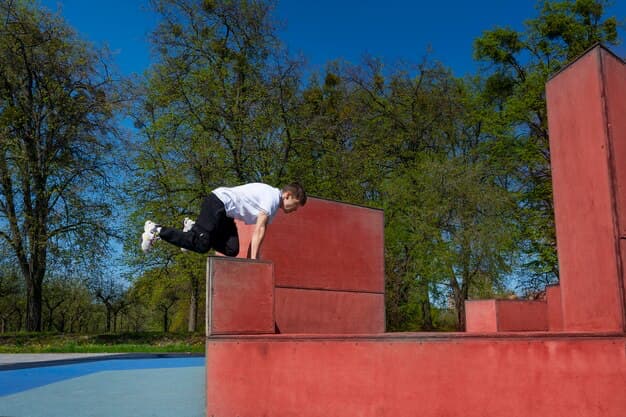Parkour, a training discipline using movement that developed from military obstacle course training, has evolved into a popular urban sport. This sport emphasizes fluidity, control, and strength, making it both a physical and mental exercise. The appeal of parkour lies in its accessibility and the freedom it offers to transform any environment into a training ground.
Essential Elements of a Parkour Training Spot
A top-notch parkour training area is more than just a collection of obstacles; it’s a carefully crafted environment designed for safety, adaptability, and progression. Key elements include:
- Safety First: The foremost priority in any parkour spot. This involves using non-slip surfaces, adequate padding, and structurally sound equipment to prevent injuries;
- Versatile Design: A great parkour spot caters to a wide range of skills, from beginners to advanced practitioners. It should include various elements that allow for progression and challenge;
- Material Matters: The choice of materials is vital for both durability and safety. High-impact absorption and weather-resistant materials ensure a longer lifespan and safer training sessions.
Why Build Your Own Parkour Vault Box?
A parkour vault box is an indispensable tool in the world of parkour, providing a platform for a plethora of movements such as jumps, vaults, and climbs. Constructing your own vault box offers several advantages:
- Customization: Tailor the dimensions and design to suit your specific skill level and training needs;
- Cost-Effective: Building your own can often be more affordable than purchasing a pre-made one;
- Skill Development: Regular practice on your vault box can significantly enhance your parkour skills.
Designing Your Parkour Vault Box: A Step-by-Step Guide
Designing a parkour vault box is a process that begins with careful planning, ensuring the final product is both functional and safe. The first step in this process is determining the dimensions of your vault box. These dimensions should be based on your personal height, skill level, and the space you have available. A taller individual or someone with more advanced skills might prefer a larger box, while beginners or those with limited space might opt for something smaller.
Once you have an idea of the size of your vault box, the next step is to select the materials you’ll use. This decision is critical, as the materials you choose will directly affect the durability and safety of your vault box. Typically, wood is the primary material used for the frame. Hardwoods or pressure-treated lumber are recommended due to their strength and longevity. The choice of wood not only ensures a sturdy structure but also affects how the box will withstand wear and tear over time.
In addition to wood, you’ll need to choose suitable padding. High-density foam or rubber mats are ideal for covering the surfaces of your vault box. This padding is crucial as it absorbs impact, reducing the risk of injury when practicing jumps and vaults. If you plan to keep your parkour vault box outdoors, you should also consider weatherproofing materials. Treatments such as sealants or weather-resistant paints can help protect your vault box from elements like rain, sun, and wind.
With the dimensions set and materials chosen, the next step is to gather all the necessary tools for construction. This includes saws for cutting the wood, drills and screws for assembly, and any other tools required for working with your chosen materials.

Maintenance and Upkeep of Your Parkour Spot
Regular maintenance ensures the longevity and safety of your parkour spot. Key aspects include:
- Routine Checks: Regular inspections for any wear and tear;
- Weatherproofing: Applying treatments to protect against rain, sun, and other elements;
- Repairs: Promptly fixing any damage to prevent accidents.
Parkour Safety: Tips and Best Practices
Safety in parkour cannot be overstated. Important safety practices include:
- Proper Warm-Ups: To prepare the body and reduce injury risk;
- Progressive Training: Gradually increasing difficulty to build skill and confidence safely;
- Spotting and Supervision: Especially for beginners or when trying new moves.
Am I Too Old To Do Parkour?
Age is not a barrier to starting parkour. Building your own parkour vault box allows you to customize your training to fit your age and fitness level. This personal approach lets older enthusiasts begin with basic movements and gradually progress, ensuring a safe and comfortable introduction to parkour. Having a personal parkour spot at home provides a convenient and less intimidating environment to practice, making it ideal for those starting parkour later in life.
Conclusion
Building and maintaining your own parkour spot, especially a vault box, offers unparalleled opportunities for skill development and enjoyment. It’s a journey that not only enhances your physical abilities but also instills a deeper appreciation for the art of movement. Start creating your own training haven and unlock your parkour potential today!